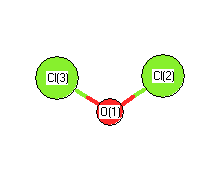Geometric Data

Point Group C2v
Internal coordinates
distances (r) in Å, angles (a) in degrees, dihedrals (d) in degrees
Cartesians
| Atom |
x (Å) |
y (Å) |
z (Å) |
| O1 |
0.0000 |
0.0000 |
0.7788 |
| Cl2 |
0.0000 |
1.3966 |
-0.1832 |
| Cl3 |
0.0000 |
-1.3966 |
-0.1832 |
Atom - Atom Distances 
Distances in Å
| |
O1 |
Cl2 |
Cl3 |
| O1 |
|
1.6959 | 1.6959 |
| Cl2 |
1.6959 |
|
2.7933 |
| Cl3 |
1.6959 | 2.7933 |
|
Calculated geometries
for Cl
2O (Dichlorine monoxide).
Experimental Bond Angles (degrees) from cartesians 
| atom1 |
atom2 |
atom3 |
angle |
| Cl2 |
O1 |
Cl3 |
110.880 |
Bond descriptions
Examples: C-C single bond, C=C, double bond, C#C triple bond, C:C aromatic bond
Connectivity
| Atom 1 |
Atom 2 |
| O1 |
Cl2 |
| O1 |
Cl3 |











